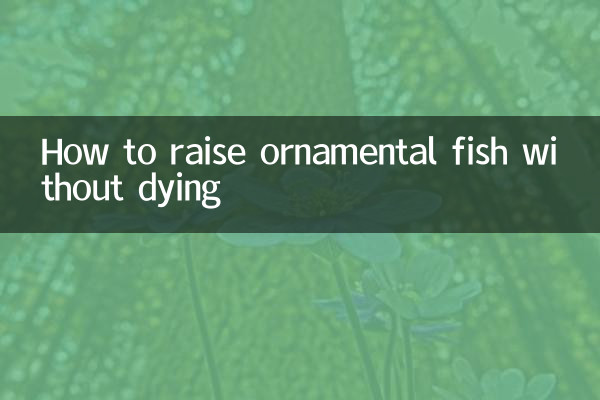How to raise ornamental fish without dying
Keeping ornamental fish is a hobby for many people, but how to keep them alive and healthy is a science. Combining the hot topics and hot content on the Internet in the past 10 days, we have compiled a detailed feeding guide to help you avoid common mistakes and keep your ornamental fish alive long and healthy.
1. Water quality management

Water quality is one of the key factors for the survival of ornamental fish. The following are the key points of water quality management:
| water quality parameters | ideal range | Things to note |
|---|---|---|
| pH value | 6.5-7.5 (freshwater fish) 7.8-8.4 (sea fish) | Regular testing to avoid drastic fluctuations |
| Ammonia nitrogen | 0mg/L | Excessive ammonia nitrogen can cause fish poisoning |
| nitrite | 0mg/L | Nitrite is an intermediate product of the nitrification process |
| Nitrate | <20 mg/L | Change water regularly to reduce concentration |
| water temperature | Adjust according to fish species (usually 22-28℃) | Use a heating rod to keep it stable |
2. Feed selection and feeding
Feed selection and feeding methods directly affect the health of fish. The following are common feed types and feeding recommendations:
| Feed type | Applicable fish species | Feeding frequency |
|---|---|---|
| pellet feed | most freshwater fish | 1-2 times a day, eat within 2 minutes each time |
| flake feed | Small fish, tropical fish | 1-2 times a day, small amount and multiple times |
| Frozen feed (e.g. bloodworms) | carnivorous fish | 2-3 times a week, feed after thawing |
| Live bait (such as bloodworms) | Enhance fish body color | 1-2 times a week, pay attention to disinfection |
3. Fish tank equipment and maintenance
Proper equipment is the basis for successful fish farming. The following are necessary equipment and maintenance recommendations:
| Device name | Function | Things to note |
|---|---|---|
| filter | Keep water clean | Clean filter media regularly to avoid clogging |
| heating rod | Adjust water temperature | Adjust temperature according to season |
| oxygen pump | Increase dissolved oxygen in water | Especially important at night |
| lighting system | Simulate natural lighting | 8-10 hours a day, avoid overexertion |
4. Common problems and solutions
You may encounter various problems during fish farming. The following are common problems and solutions:
| question | Possible reasons | Solution |
|---|---|---|
| Fish floating head | Lack of oxygen or deterioration of water quality | Add oxygen pump and change water |
| Fish body expression point | White spot disease (parasite) | Raise the temperature to 30°C, add salt or treat with medication |
| fish not eating | environmental stress or illness | Check water quality, isolate and observe |
| Fish tank water is turbid | Insufficient filtration or overfeeding | Reduce feeding and increase filtration |
5. Things to note when introducing new fish into the tank
The introduction of new fish into the tank is a critical step, and improper handling can easily lead to the death of the fish. Here are the steps for adding a new fish to your tank:
1.Overtemperature: Place the fish bag into the fish tank for 30 minutes to allow the water temperature to gradually become consistent.
2.Cross the water: Add a small amount of fish tank water to the bag every 10 minutes for 1 hour.
3.quarantine: It is best to put new fish in an isolation tank for observation for 1-2 weeks.
4.Reduce light: After entering the tank, keep the environment dark to reduce stress.
6. Key points for raising different fish species
| Fish species | Suitable water temperature | special needs |
|---|---|---|
| goldfish | 18-24℃ | Requires a lot of space and easily produces a lot of waste |
| Guppy | 24-28℃ | Likes weakly alkaline water and has strong reproductive ability |
| betta fish | 26-30℃ | Solitary culture, requires still water environment |
| Colorful Angelfish | 28-32℃ | It has extremely high requirements on water quality and is suitable for experienced breeders. |
7. Summary
The key to keeping ornamental fish alive isStable water quality, proper feeding, proper equipment and careful observation. Through the guidance of the above structured data, you can systematically master the key points of fish farming. Remember, fish farming is a process that requires patience. Only by persevering in every detail can your ornamental fish live a healthy and happy life.
Final reminder:Don't overfeed, this is the most common mistake made by novices;Change water regularly(Replace 1/3 of the water volume every week);Observe fish behavior, detect abnormalities in time. Happy fish farming!

check the details

check the details